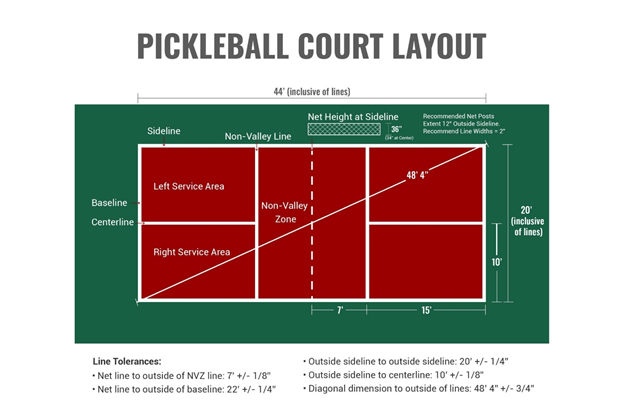Pickleball Court Construction-- Beginning Structure Your Perfect Court Today
Pickleball Court Construction-- Beginning Structure Your Perfect Court Today
Blog Article
Sustainable Practices in Pickleball Court Construction You Should Know
As the popularity of pickleball remains to increase, so too does the demand for lasting techniques in court building and construction. This approach not just addresses ecological worries however additionally enhances the durability and capability of the courts. From choosing green products to implementing effective drain and energy-saving lighting services, there are various techniques to think about. The influence of these methods prolongs far past the court itself. Understanding just how each element contributes to a more lasting future welcomes additionally exploration into the intricate equilibrium between recreational development and ecological stewardship.
Selecting Eco-Friendly Materials
Selecting environment-friendly products is a critical action in the construction of sustainable pickleball courts. The selection of lasting materials not only minimizes ecological influence yet likewise enhances the longevity and efficiency of the court. Key materials consist of reused rubber for the surface, which provides excellent longevity and shock absorption while drawing away waste from garbage dumps.
Additionally, utilizing in your area sourced products minimizes transportation exhausts and sustains regional economies. Pickleball court construction. Utilizing indigenous woods for fence and seating can provide a sustainable visual while making certain resilience against the aspects.
Incorporating permeable products for court foundations can additionally contribute to sustainability by allowing for all-natural water drain and minimizing drainage. These selections not only protect regional ecological communities yet additionally promote healthier play settings.
Reliable Drain Solutions
While the choice of environment-friendly materials is vital, implementing effective drainage options is similarly important for maintaining sustainable pickleball courts. Proper drain not only secures the court surface from water damages however additionally lessens disintegration and overflow, promoting environmental stability.
Efficient water drainage systems can include absorptive paving, which permits water to penetrate the ground instead of pooling externally. This lowers the probability of standing water, which can bring about mold and mildew and other upkeep issues. In addition, incorporating tactically placed water drainage networks and swales can direct excess water away from the court area, ensuring a completely dry playing surface and avoiding dirt erosion.
Utilizing native plant life in the landscape design around the courts can even more improve drainage by absorbing excess water and minimizing drainage. These plants call for less irrigation and advertise biodiversity, straightening with sustainable techniques.
Moreover, it is essential to consistently preserve the drain system to ensure its long-lasting performance. This consists of clearing up debris and tracking for clogs. By focusing on reliable water drainage services, pickleball court manufacturers can substantially add to the sustainability and long life of the center, inevitably profiting both players and the environment.
Energy-Efficient Lights Options
As the demand for pickleball proceeds to expand, integrating energy-efficient lights choices right into court style has come to be significantly important for sustainability. Standard lighting systems frequently eat too much energy, adding to higher operational expenses and ecological effect. As a result, taking on contemporary, energy-efficient innovations is essential for both new building and constructions and remodellings.
LED (Light Emitting Diode) illumination stands out as a leading choice because of its long life and power financial savings (Pickleball court construction). Contrasted to conventional illumination, LEDs make use of roughly 75% much less energy and can last as much as 25 times much longer, substantially minimizing upkeep costs. Moreover, the directional nature of LED lighting reduces light contamination, guaranteeing that lighting is concentrated on the court instead than bordering locations.

Sustainable Surface Area Alternatives
Checking out sustainable surface area alternatives for pickleball courts has gained traction amongst players and building contractors alike. The focus on environment-friendly materials not just lines up with the expanding ecological understanding yet likewise improves the efficiency and longevity of the courts.
This material supplies exceptional shock absorption, decreasing the danger of injuries for players while promoting sustainability. These floor tiles are easy to install and replace, and their adaptability permits for numerous court setups.
Natural lawn courts are likewise becoming a sustainable option, promoting biodiversity and minimizing the heat island effect. Nevertheless, they call for routine maintenance and water, which might not line up with all sustainability objectives.

Water Preservation Techniques

Another effective technique involves the installment of rain harvesting systems. These systems save and collect rain for usage in maintaining court surfaces and landscape design. This strategy not just saves safe and clean water however additionally lowers dependence on community resources.
Furthermore, employing drought-resistant landscape design around the courts is important. Indigenous plants call for less water and are much better adapted to local climate problems, hence lowering total water consumption. Additionally, utilizing efficient irrigation systems, such as drip watering, makes certain that water is delivered directly to plant roots, lessening dissipation and waste.
Verdict
Incorporating lasting practices in pickleball court building and construction considerably adds to ecological preservation and resource efficiency. By prioritizing these methods, the building and construction of pickleball courts can align with broader environmental objectives while advertising long life and capability within communities.
As the popularity of pickleball continues to rise, so too does the need for sustainable practices in court building.Selecting environment-friendly products is a crucial step in the navigate here building and construction of sustainable pickleball courts. By prioritizing energy-efficient illumination options, pickleball court fitters can add to a much more sustainable future while meeting the demands of stakeholders and players alike.Incorporating lasting surface options not only boosts the efficiency of pickleball courts however also leads the way for executing effective water conservation strategies.Incorporating lasting methods in pickleball court construction dramatically contributes to environmental preservation and source effectiveness.
Report this page